Instructional Series
Welcome to the English medium literacy instructional series teaching and learning resources for years 1 to 8.

- Gold
- Purple
- Orange
- 2
- 3
- 4
- 1
- 4
- 6
- 8
- 5
- 3
- 7
- English
- Social Sciences
- Science
- Health and Physical Education
- Technology
- The Arts
- Learning Languages
- Non-fiction
- Fiction
- None
- Nature of science
- Living world
- Nature of technology
- Technological knowledge
- Critique evidence
- Engage with science
- Articles
- Stories
- Poems
- Kākano | Seed
- Māhuri | Sapling
- Rākau | Tree
- Tupu | Seedling
- Consonant digraphs
- Short vowels
- Single consonants
Search results
82 items - Showing 1 - 10
-

Nga Mahi a te Rehia Maori Games
by Ross Calman
“In early Māori society, games were played by everyone …” This report describes eight traditional Māori games and lists several more.
-
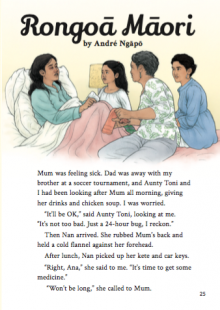
Rongoā Māori
by André Ngāpō
illustrations by Elspeth Alix Batt
This story has a strong theme of the value of rongoā Māori, traditional Māori medicine. It provides opportunities for students who are familiar with te reo and rongoā Māori to share their knowledge. Ana’s mum is ill, and when Nan comes to visit, she decides that rongoā Māori is what Mum needs. Nan takes Ana into the bush with her to collect the plants she wants to use. Ana is fascinated by what Nan shows her, and Nan agrees to teach Ana more about traditional Māori medicine. After using rongoā Māori to treat an unexpected emergency, they return home to prepare the leaves of koromiko they have collected to treat Mum’s illness.
Purple 2
-
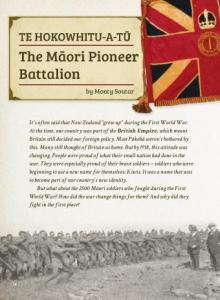
Te Hokowhitu-a-Tū: The Māori Pioneer Battalion
by Monty Soutar
This article tells the story of Māori and the First World War and of the huge contribution made by the pioneer Māori Battalion. The topic will be unfamiliar for many students, but the themed content in the surrounding items will provide support.
-

Kurī
by Priscilla Wehi
illustrations by Spike Wademan
Māori brought the kurī or Polynesian dog with them when they migrated to Aotearoa New Zealand. This article looks at what we know about kurī, their origins, what they were used for, and why they died out. It incorporates traditional stories about the explorers Tāneatua and Īhenga and explains the importance of kurī to early Māori society. “Kurī” is a fascinating but challenging article at this year level, and you may wish to approach it in sections.
-
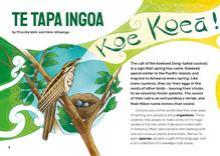
Te Tapa Ingoa
This article explores how early Māori went about naming and grouping the plants and animals they found around them. It explains what this process reveals about Māori ways of viewing the world and the framework provided by whakapapa. It prompts comparisons with the Linnaean system for naming and grouping organisms and describes an example of Māori and Pākehā working together and drawing on knowledge from both systems.
-
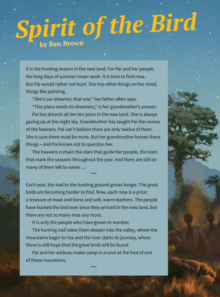
Spirit of the Bird
by Ben Brown
illustrations by Tom Simpson
The bird of the title is the moa, and this fictional story is set in the time of the early Māori moa hunters. Little is known of this era, but the author conveys (often indirectly) the hardships of a subsistence lifestyle and the impact of human settlement on the moa.
-
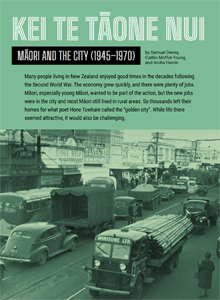
Kei te Tāone Nui: Māori and the City (1945–1970)
by Samuel Denny, Caitlin Moffat-Young, and Aroha Harris
The post-Second-World-War era in Aotearoa New Zealand saw one of the fastest rates of urban migration in the world, with Māori migrating to cities in large numbers to take advantage of new economic opportunities. The “golden city” offered much, but it came at a high price. Despite an unquestioned narrative in Pākehā communities that New Zealand’s race relations were world leading, Māori moving to the city encountered prejudice and discrimination at many levels. Māori responded to these challenges in multiple ways, for example, by establishing formal and informal groups that strengthened collective expression of Māori cultural values and practices. By gathering together to debate and take action on key issues, the seeds were sown for the modern Māori protest movement as well as the forging of a new urban Māori identity.
-
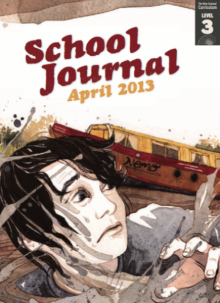
Tīvaevae
by Teremoana Hodges
In this well-illustrated article, we learn about the origins, meanings, and construction of tīvaevae, the beautiful hand-sewn Cook Islands Māori bedspreads. The text provides opportunities for students to be exposed to and engage with the positive values that are associated with the concept of akano‘anga Kūki‘Āirani (Cook Islands culture). These are highlighted through the description of the time, hard work, and skill involved in making tīvaevae and the beauty of the finished product.
-
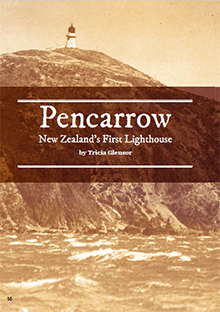
Pencarrow: New Zealand’s First Lighthouse
by Tricia Glensor
New Zealand’s coastline has always been a dangerous place for ships and boats. Early Māori knew that. Several traditional stories tell of waka being washed onto rocks in storms. Since the 1790s, when the first Pākehā reached New Zealand, more than 2,300 ships have been wrecked in New Zealand waters.
-
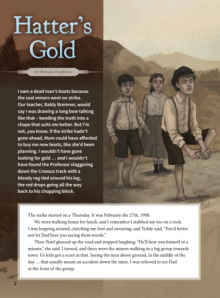
Hatter’s Gold
by Renata Hopkins
illustrations by Matt Haworth
This historical fiction story is set in the West Coast mining town of Blackball in the early 1900s. Laurie, a twelve-year-old boy whose father is a coal miner, tells the story. When the miners go on strike, Laurie realises his family won’t be able to afford the new boots he needs. Laurie sets off to find some gold. Instead he finds a fatally injured old miner (a “hatter”) who opens up the possibility that there are more options than mining.








 Literacy Online home
Literacy Online home
